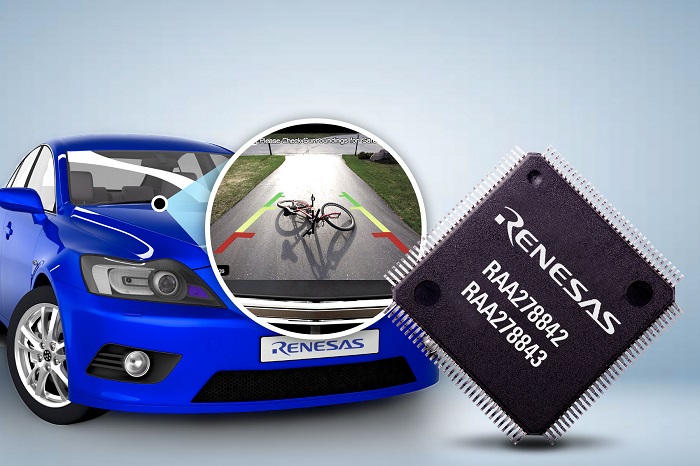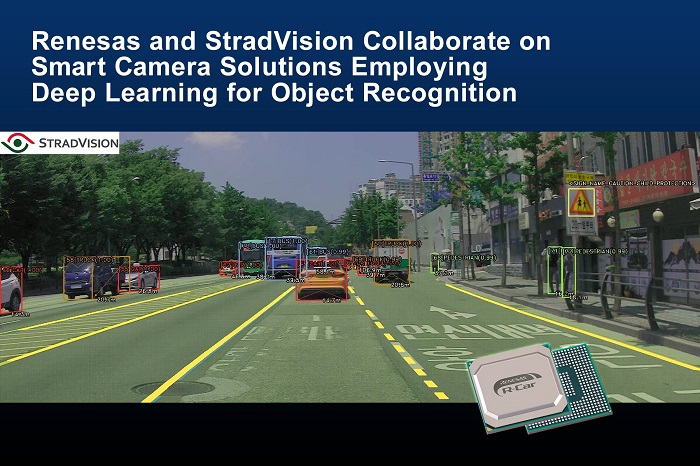By Gina Roos, editor-in-chief
Renesas Electronics Corp. is claiming the automotive industry’s first full HD 1080p LCD video controller with a four-lane MIPI-CSI2 input. The RAA278842 LCD video controller’s four-lane (or dual two-lane) MIPI-CSI2 input supports up to 1 Gbits/s per lane to interface with the latest generation of automotive cameras, application processors, and graphics processors.
The LCD video controller also supports a 150 MHz single-channel OpenLDI interface, and a variety of video interfaces and LCD panel sizes with resolutions up to 1920 × 1080. Applications include automotive central infotainment displays (CIDs) and head units, instrument clusters, head-up displays (HUDs), and mirror replacement display applications, primarily targeting advanced driver assistance systems (ADAS).

The RAA278842 LCD video controller provides 10-bit per color processing built into the image enhancement engine to provide near-zero latency, high-quality video. It also features integrated video diagnostics to detect if the incoming video is frozen or corrupted and can provide a direct path for the rear camera video to be displayed on the LCD. Renesas said this significantly improves rear camera display reliability, virtually eliminating the possibility of a software-related problem causing the rear camera video to be displayed incorrectly or not at all.
In addition, the RAA278842 can display the camera image on an LCD in less than 500 milliseconds, thereby addressing the fast boot requirement of many OEMs.
Renesas also offers the RAA278843 with traditional BT.656 output. Both the RAA278842 and RAA278843 operate with the system’s main processor to monitor the camera and the video data coming from the SoC or GPU. Both controllers enable compliance with the FMVSS-111 safety law, which requires the blind spot area behind the vehicle to be displayed in less than two seconds after the driver places the vehicle in reverse gear.
Key Features of RAA278842 and RAA278843
- Two input measurement engines with frozen/abnormal image detection diagnostics to monitor input from the SoC/GPU and camera
- EEPROM/SPI flash fast boot allows register programming without requiring an external microcontroller
- SPI flash-based on-screen display (OSD) capable of presenting bit-map graphics in nine windows
- Arbitrary horizontal and vertical scalers for outputting up to 1080p (1920 × 1080) resolution
- Proprietary smooth input switching eliminates flicker when switching between sources
- AEC-Q100 Grade-2 qualified and specified for operation from -40°C to 105°C
The RAA278842 and RAA278843 can be combined with Renesas’ R-Car SoC family, RH850 MCU family, and RL78 MCU family, as well as the ISL78302 dual LDO, ISL78322 dual 2 A/1.7 A synchronous buck regulator, and ISL78228 dual 800 mA synchronous buck regulator to provide power rails for the RAA27884x and other ICs on the automotive infotainment system board.
Both the RAA278842 (14 × 14 mm, 128-lead LQFP) and RAA278843 (14 × 14 mm, 128-lead LQFP) are available in volume production.
Smart camera development
Renesas also announced a collaboration with StradVision, Inc., a vision processing technology solutions provider for autonomous vehicles. The two companies will jointly develop a deep learning-based object recognition solution for smart cameras used in next-generation ADAS applications and cameras for ADAS Level 2 and above.
Next-generation ADAS implementations require high-precision object recognition capable of detecting vulnerable road users (VRUs) such as pedestrians and cyclists, said Renesas. At the same time, these systems must consume very low power for mass-market mid-tier to entry-level vehicles.

The new solution will leverage StradVision’s deep learning–based object recognition software for recognizing vehicles, pedestrians, and lane marking, which has been optimized for Renesas’ R-Car automotive system-on-chip (SoC) products R-Car V3H and R-Car V3M. The R-Car SoCs incorporate a dedicated engine for deep learning processing called CNN-IP (Convolution Neural Network Intellectual Property), enabling them to run StradVision’s SVNet automotive deep learning network at high speed with minimal power consumption.
The Renesas R-Car SoCs featuring the new joint deep learning solution, including software and development support from StradVision, will be available to developers by early 2020.
Advertisement
Learn more about Electronic Products MagazineRenesas Electronics America





